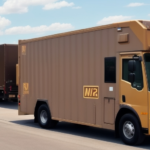Understanding the Basic Rates for UPS Shipping
When it comes to shipping, UPS is one of the most popular options available, trusted by businesses and individuals alike. However, understanding their rates and fees can be challenging, especially for new users. In this article, we will delve into the basics of UPS shipping rates, explore the different shipping options, highlight tips and tricks for saving money, and cover other important considerations to keep in mind.
How to Calculate Shipping Costs with UPS
If you're wondering how much your shipment will cost, UPS uses a variety of factors to determine shipping rates. These factors include:
- Package Dimensions and Weight: Heavier and larger packages generally cost more to ship.
- Shipping Method: Options range from ground to expedited air services.
- Destination: Domestic and international shipments have different pricing structures.
To determine the cost of your package, you can use the UPS rate calculator on their website or call UPS directly for a quote. Keep in mind that additional fees and surcharges may also apply, which we will discuss later.
UPS offers various shipping options to fit your needs:
- Expedited Shipping: For faster delivery times.
- Ground Shipping: A cost-effective option that may take longer.
- Special Services: Such as signature confirmation and insurance for an additional fee.
Consider all options and any additional services you may need when calculating your shipping costs with UPS to ensure you choose the most efficient and economical method for your requirements.
Overview of UPS's Domestic and International Shipping Options
UPS offers a comprehensive range of shipping options, including ground, air, and freight services for both domestic and international shipments:
- Ground Shipping: Typically the most cost-effective for shipments within the United States, with delivery times ranging from 1-5 business days depending on distance.
- Air Services: For international shipments, UPS air services offer fast delivery times, usually within 1-3 business days depending on the destination.
- Freight Services: Ideal for larger shipments or those weighing over 150 lbs.
Additionally, UPS provides various tools and resources to help manage your shipments effectively:
- Real-Time Package Tracking: Monitor your shipment’s progress every step of the way.
- Scheduled Pickups: Convenient scheduling options to fit your schedule.
- Customized Delivery Options: Tailor delivery to meet specific needs.
With a global network spanning over 220 countries and territories, UPS is a reliable choice for both domestic and international shipping needs. For more detailed information, refer to the UPS International Shipping Options.
Tips for Saving Money on UPS Shipping Rates
There are several strategies you can employ to save money on your UPS shipments:
- Compare Shipping Carriers: Use tools to compare rates with other major shipping carriers like FedEx and USPS to ensure you're getting the best deal.
- Purchase and Print Labels Online: Buying labels online can often result in lower costs compared to purchasing them in-person.
- Use UPS SurePost: This service combines UPS ground transport with final delivery by the US Postal Service, which can be cheaper than traditional ground shipping.
- Bundle Shipments: Shipping multiple packages together can reduce overall shipping costs.
Additionally, consider the size and weight of your packages:
- Weight Discounts: UPS offers discounts for packages weighing over 50 pounds.
- Size Considerations: Keeping packages within standard size limits can help avoid additional fees. For larger items, consider using UPS’s freight services.
Implementing these strategies can significantly reduce your shipping expenses while ensuring your packages are delivered efficiently.
Understanding the Different UPS Package Sizes and Weights
UPS provides a variety of packaging options to accommodate different shipping needs:
- Standard Packages: Range from small envelopes to boxes weighing up to 150 lbs.
- Dimensional Weight: UPS considers both the size and weight of your package, so accurate measurements are crucial to avoid overpaying.
When packaging, consider the fragility of your items. For delicate or breakable items:
- Use Adequate Cushioning: Materials like bubble wrap and foam inserts provide necessary protection.
- Secure Packaging: Ensure your items are properly secured and labeled to prevent damage during transit.
For international shipments, be aware of customs regulations and restrictions:
- Prohibited Items: Certain items may be restricted or require special documentation.
- Customs Compliance: Research destination country regulations to avoid delays or additional charges.
For comprehensive guidelines, visit the UPS Packaging Guide.
How to Track Your UPS Shipment in Real-Time
Tracking your UPS shipment is straightforward using their online tracking system:
- Real-Time Updates: Monitor the location and expected delivery time of your package.
- UPS My Choice: Sign up for additional tracking features and delivery alerts for enhanced convenience.
Different tracking options are available depending on your shipment type:
- Hazardous Materials: May require a specialized tracking system.
- International Shipments: Utilize UPS's international tracking system for accurate updates.
Always verify with UPS to ensure you are using the correct tracking system for your specific shipment needs.
Comparing UPS Rates to Other Major Shipping Carriers
When selecting a shipping carrier, it's essential to compare rates and services offered by different carriers. Key competitors include FedEx and the US Postal Service (USPS).
- Delivery Speed: UPS offers various delivery options such as next-day, 2-day, and 3-day delivery. Similarly, FedEx and USPS provide comparable speed options, but pricing may vary based on the selected service.
- Cost vs. Speed: Faster delivery typically incurs higher costs. Assess whether the speed of delivery justifies the additional expense for your specific needs.
- Customer Service: UPS is renowned for excellent customer service, with a dedicated team available to address queries and resolve issues. While FedEx and USPS also offer customer support, service levels may vary.
To make an informed decision, utilize comparison tools and consider factors like delivery speed, cost, and customer service reputation. For an in-depth comparison, refer to the Compare UPS, FedEx, USPS guide.
Choosing the Right UPS Service Level for Your Needs
UPS offers several service levels to accommodate different shipping requirements:
- Standard Ground Shipping: Cost-effective for non-urgent deliveries.
- 2-Day Air: Balances speed and cost for moderately urgent shipments.
- Overnight Express: Ensures next-day delivery for urgent packages.
When selecting a service level, consider the following factors:
- Urgency: How quickly does the package need to arrive?
- Destination: Domestic vs. international destinations can affect service availability and cost.
- Cost: Faster shipping options typically come at a higher price point.
- Package Size and Weight: Some services have restrictions that may limit your choices.
- Additional Features: Services like signature confirmation or insurance may be necessary for valuable shipments.
Carefully review the details of each service level to ensure you select the option that best meets your shipping needs. For more information, visit the UPS Service Levels page.
Understanding Additional Fees and Surcharges on UPS Shipments
In addition to basic shipping rates, UPS may charge additional fees and surcharges based on specific shipment criteria:
- Fuel Surcharges: These fluctuate based on current fuel prices and are not included in the initial shipping quote.
- Address Correction Fees: Applied when the recipient’s address is incorrect or incomplete, necessitating corrections.
- Delivery Area Surcharges: Additional fees may apply for deliveries to remote or difficult-to-access locations.
Understanding these fees beforehand can help you avoid unexpected charges:
- Fuel Surcharge Monitoring: Keep an eye on fuel price trends to anticipate changes in shipping costs.
- Accurate Address Information: Double-check recipient addresses to prevent address correction fees.
- Service Area Awareness: Be aware of any additional surcharges associated with delivery locations.
For a detailed breakdown of UPS fees and surcharges, refer to the UPS Fees and Surcharges guide.
How to Estimate Delivery Times with UPS Shipping
Estimating delivery times with UPS depends on several factors, including the chosen service level and the shipment’s destination. Here are tools and tips to help you accurately estimate delivery times:
- UPS Rate Calculator: Obtain estimates based on package weight, dimensions, origin, and destination.
- Tracking System: Use real-time tracking to monitor your package’s progress and update delivery estimates as needed.
Consider the following when estimating delivery times:
- Service Level: Faster services like Overnight Express will have shorter delivery times compared to Ground Shipping.
- Destination: Domestic shipments generally deliver faster than international ones.
- Seasonal Factors: Holidays or unforeseen events (e.g., weather disruptions) can impact delivery schedules.
Ensure you double-check the estimated delivery time before shipping to guarantee that your package arrives when needed. For more accurate estimates, visit the UPS Delivery Estimator.
The Impact of COVID-19 on UPS Shipping Rates and Delivery Times
The COVID-19 pandemic has significantly impacted shipping rates and delivery times across the globe, and UPS is no exception. Despite operating continuously during the pandemic, several factors have influenced UPS's services:
- Increased Shipping Volumes: The surge in e-commerce led to higher demand, which strained logistics and delivery capacities.
- Workforce Challenges: Health protocols and restrictions affected staffing levels, potentially leading to delays.
- Policy Changes: Adjustments to shipping policies and procedures were necessary to comply with health guidelines and safety measures.
While UPS has managed to maintain operations, some delays and changes to shipping policies may still occur. It's crucial to stay updated with the latest information from UPS to ensure your packages arrive on time. For current updates, refer to the UPS COVID-19 Updates page.
Best Practices for Packaging Your Items for Safe UPS Shipment
Proper packaging is essential to ensure the safe and secure transport of your items with UPS. Follow these best practices to minimize the risk of damage during transit:
- Use Sturdy Materials: Select durable boxes or envelopes appropriate for the contents you are shipping.
- Protect Fragile Items: Utilize cushioning materials such as bubble wrap, foam inserts, or packing peanuts to secure delicate items.
- Seal Packages Securely: Use high-quality packing tape to reinforce all seams and edges of the package.
- Label Clearly: Ensure that addresses are legible and placed prominently on the package.
Additional tips include:
- Double-Boxing: For extra protection, place your item in a box and then place that box inside a larger one with additional padding.
- Avoid Overpacking: Ensure that the package is not overfilled, which can cause items to shift and lead to damage.
Adhering to these packaging guidelines will help ensure that your items arrive safely and undamaged. For detailed packaging instructions, visit the UPS Packaging Tips section.
Tips for Negotiating Lower UPS Shipping Rates for Your Business
Businesses that frequently ship packages with UPS can often negotiate lower shipping rates through various strategies:
- Direct Negotiation: Contact a UPS representative to discuss your shipping needs and explore potential rate reductions based on volume and frequency.
- Use Third-Party Shipping Platforms: Platforms like ShipScience can negotiate better rates on your behalf by leveraging collective shipping volumes.
- Enroll in UPS Business Programs: Programs such as UPS My Business offer benefits and discounts tailored to business shipping needs.
Additional strategies include:
- Consolidate Shipments: Combining multiple shipments into a single larger shipment can result in cost savings.
- Optimize Package Sizes: Ensure packages are sized appropriately to maximize space and minimize dimensional weight charges.
Implementing these strategies can lead to significant savings on your shipping costs. For assistance in negotiating rates, visit the Negotiating UPS Rates guide.
Understanding Customs Regulations for International UPS Shipments
Shipping internationally with UPS requires a thorough understanding of the customs regulations and requirements of the destination country. Key considerations include:
- Import Fees and Duties: These are taxes imposed by the destination country on imported goods. They vary depending on the product type and value.
- Customs Documentation: Accurate and complete documentation is essential to clear customs smoothly. This may include commercial invoices, packing lists, and certificates of origin.
- Prohibited and Restricted Items: Certain items may be banned or require special permits. Always verify if your items are allowed in the destination country.
To ensure compliance:
- Research Destination Regulations: Each country has its own set of rules and it's important to familiarize yourself with them before shipping.
- Use UPS Resources: UPS provides comprehensive resources and guidance to help you navigate international shipping requirements.
Failure to comply with customs regulations can result in delays, additional fees, or even the return of your shipment. For detailed information, consult the UPS International Customs resources.
Top Mistakes to Avoid When Using UPS for Your Shipping Needs
To ensure a smooth and hassle-free shipping experience with UPS, it's important to avoid common mistakes:
- Inaccurate Measurements: Incorrectly measuring or weighing your package can lead to unexpected costs or shipping delays.
- Poor Packaging: Not using adequate packaging materials increases the risk of damage during transit.
- Overlooking Fees and Surcharges: Failing to account for additional fees can result in higher-than-expected shipping costs.
- Incorrect Address Information: Mistakes in the recipient's address can cause delivery issues and additional charges.
- Ignoring Tracking: Not utilizing UPS’s tracking tools can leave you uninformed about your shipment’s status.
By avoiding these errors and adhering to the best practices outlined in this article, you can ensure that your UPS shipping experience is efficient and cost-effective. For more tips on avoiding shipping mistakes, visit the UPS Shipping Mistakes guide.






















